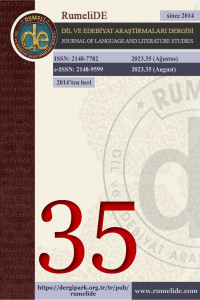Abstract
References
- Akalın, R. (2018). Çeviri Kuramından Çeviri Eğitimine: Akademik Çeviri Eğitiminin Temel İlkelerini Belirleme. Nobel Akademik Yayıncılık.
- Balcı, A. (2016). Sosyal bilimlerde araştırma yöntem, teknik ve ilkeler. Pegem Akademi.
- Boztaş, İ. (1992). Çeviri, çeviride eşdeğerlilik ve dilbilim. Dilbilim, 20, 249-255.
- Durukan, E. (2018). Çeviri Öğretimi: Hedef ve Ölçme. Hiperyayın.
- Eser, O. (2015). A model of translator’s competence from an educational perspective. International Journal of Comparative Literature and Translation Studies, 4-15.
- EMT. (2009). Competencies for Professional Translator, Experts in Multilingual and Multimedia Communication. Brussels. 03 17, 2023 tarihinde https://ec.europa.eu/info/sites/info/files/emt_competences_translators_en.pdf adresinden alındı.
- Kaş, B. (2022). ÇEVİRMEN EDİNCİ Temel Bilgiler, Edimsel Beceriler ve Mesleki Anlayış Parametreleri. Vizetek Yayıncılık.
- Kiraly, D. (2013). Towards a view of translator competence as an emergent phenomenon: Thinking outside the box (es) in translator education. New prospects and perspectives for educating language mediators, 197-224.
- Köktürk, Ş., & Türkmen, G. (2020). A Recommendation of Translator Competence and its Components. International Journal of Languages Education and Teaching, 188-197.
- Neubert, A. (2000). Competence in Language, Languages, and Translation. Benjamins Translation Library.
- PACTE. (2003). Building a translation competence model. Triangulating translation: perspectives in process-oriented research, 43-69.
- Patton, M. Q. (2002). Qualitative research and evaluation methods. SAGE Publishing.
- Salihoğlu, G. H. (2018). Kişilik Özellikleri, Kariyer Eğilimi Ve Mesleki Başari Algisi Arasindaki İlişkinin İncelenmesine Yönelik Bir Araştirma. The International New Issues in Social Sciences, 55-7.
- Schaffner, C. (2000). Running before walking? Designing a translation programme at undergraduate level. Benjamins Translation Library, 38, 143-156.
- Tokat Gaziosmanpaşa University. (2023, 05 26). Tokat Gaziosmanpaşa University Course Information Package: https://obs.gop.edu.tr/oibs/bologna/index.aspx? lang=en&curOp=showPac&curUnit=44&curSunit=2001595# adresinden alındı.
- Türkmen, B. (2019). Çeviri Eğitiminde Teknoloji ve Dijital Medya Edinci. Gece Akademi.
- YÖK ATLAS. (2023, 05 22). Yükseköğretim Program Atlası: https://yokatlas.yok.gov.tr/onlisans-program.php?b=40005 adresinden alındı.
- Yücel, F. (2016). Çevirinin Tarihi. Çeviribilim Yayınları.
A curriculum analysis of applied English translation program in the scope of translator competence: The case of Tokat Gaziosmanpasa University
Abstract
In today's world, the increasing desire and need for internationalization in all areas of life have increased the interaction of people speaking different languages in parallel. This situation has revealed how important the need for translation and translator is. Thus, translator training programs have become increasingly common in Turkiye and worldwide. In addition to the departments of Translation and Interpreting that offer undergraduate translation education, Applied English Translation programs at associate degrees have also been constituted. Curriculums designed to train translators, whether at undergraduate or associate degree, need to be constantly updated in line with the needs of the translation industry. The developments that cause this update can be exemplified as technological innovations, collaborations developed in different fields, and emerging markets in this sense. The translators need various knowledge, skills, and professional competencies to provide the translation service expected from them. Whereas these competencies are expressed as translation competence, a higher term in some studies, some researchers have preferred to use the concept of translator competence for the same phenomenon. Regardless of the preferred concept, this phenomenon is considered a central element in curriculum design. This competence is gained through translation training programs offered at different levels (undergraduate or associate degree) in higher education institutions. This study aims to present, in the case of Tokat Gaziosmanpaşa University, to what extent the Applied English Translation program curriculum given at the associate degree covers the translator competence required by the translator candidate.
Keywords
Translator competence translation training translation training program applied English translation curriculum analysis
References
- Akalın, R. (2018). Çeviri Kuramından Çeviri Eğitimine: Akademik Çeviri Eğitiminin Temel İlkelerini Belirleme. Nobel Akademik Yayıncılık.
- Balcı, A. (2016). Sosyal bilimlerde araştırma yöntem, teknik ve ilkeler. Pegem Akademi.
- Boztaş, İ. (1992). Çeviri, çeviride eşdeğerlilik ve dilbilim. Dilbilim, 20, 249-255.
- Durukan, E. (2018). Çeviri Öğretimi: Hedef ve Ölçme. Hiperyayın.
- Eser, O. (2015). A model of translator’s competence from an educational perspective. International Journal of Comparative Literature and Translation Studies, 4-15.
- EMT. (2009). Competencies for Professional Translator, Experts in Multilingual and Multimedia Communication. Brussels. 03 17, 2023 tarihinde https://ec.europa.eu/info/sites/info/files/emt_competences_translators_en.pdf adresinden alındı.
- Kaş, B. (2022). ÇEVİRMEN EDİNCİ Temel Bilgiler, Edimsel Beceriler ve Mesleki Anlayış Parametreleri. Vizetek Yayıncılık.
- Kiraly, D. (2013). Towards a view of translator competence as an emergent phenomenon: Thinking outside the box (es) in translator education. New prospects and perspectives for educating language mediators, 197-224.
- Köktürk, Ş., & Türkmen, G. (2020). A Recommendation of Translator Competence and its Components. International Journal of Languages Education and Teaching, 188-197.
- Neubert, A. (2000). Competence in Language, Languages, and Translation. Benjamins Translation Library.
- PACTE. (2003). Building a translation competence model. Triangulating translation: perspectives in process-oriented research, 43-69.
- Patton, M. Q. (2002). Qualitative research and evaluation methods. SAGE Publishing.
- Salihoğlu, G. H. (2018). Kişilik Özellikleri, Kariyer Eğilimi Ve Mesleki Başari Algisi Arasindaki İlişkinin İncelenmesine Yönelik Bir Araştirma. The International New Issues in Social Sciences, 55-7.
- Schaffner, C. (2000). Running before walking? Designing a translation programme at undergraduate level. Benjamins Translation Library, 38, 143-156.
- Tokat Gaziosmanpaşa University. (2023, 05 26). Tokat Gaziosmanpaşa University Course Information Package: https://obs.gop.edu.tr/oibs/bologna/index.aspx? lang=en&curOp=showPac&curUnit=44&curSunit=2001595# adresinden alındı.
- Türkmen, B. (2019). Çeviri Eğitiminde Teknoloji ve Dijital Medya Edinci. Gece Akademi.
- YÖK ATLAS. (2023, 05 22). Yükseköğretim Program Atlası: https://yokatlas.yok.gov.tr/onlisans-program.php?b=40005 adresinden alındı.
- Yücel, F. (2016). Çevirinin Tarihi. Çeviribilim Yayınları.
Details
| Primary Language | English |
|---|---|
| Subjects | Translation and Interpretation Studies |
| Journal Section | Translation and interpreting |
| Authors | |
| Publication Date | August 21, 2023 |
| Published in Issue | Year 2023 Issue: 35 |


